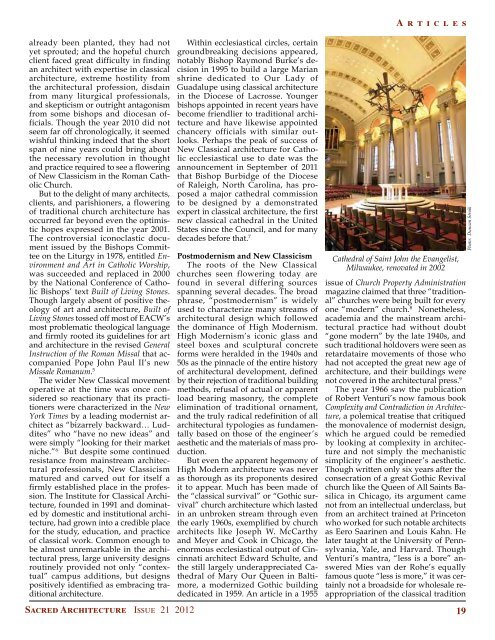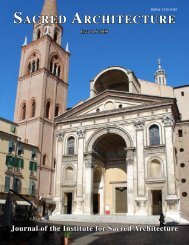Download Issue PDF - The Institute for Sacred Architecture
Download Issue PDF - The Institute for Sacred Architecture
Download Issue PDF - The Institute for Sacred Architecture
Create successful ePaper yourself
Turn your PDF publications into a flip-book with our unique Google optimized e-Paper software.
Articlesalready been planted, they had notyet sprouted; and the hopeful churchclient faced great difficulty in findingan architect with expertise in classicalarchitecture, extreme hostility fromthe architectural profession, disdainfrom many liturgical professionals,and skepticism or outright antagonismfrom some bishops and diocesan officials.Though the year 2010 did notseem far off chronologically, it seemedwishful thinking indeed that the shortspan of nine years could bring aboutthe necessary revolution in thoughtand practice required to see a floweringof New Classicism in the Roman CatholicChurch.But to the delight of many architects,clients, and parishioners, a floweringof traditional church architecture hasoccurred far beyond even the optimistichopes expressed in the year 2001.<strong>The</strong> controversial iconoclastic documentissued by the Bishops Committeeon the Liturgy in 1978, entitled Environmentand Art in Catholic Worship,was succeeded and replaced in 2000by the National Conference of CatholicBishops’ text Built of Living Stones.Though largely absent of positive theologyof art and architecture, Built ofLiving Stones tossed off most of EACW’smost problematic theological languageand firmly rooted its guidelines <strong>for</strong> artand architecture in the revised GeneralInstruction of the Roman Missal that accompaniedPope John Paul II’s newMissale Romanum. 5<strong>The</strong> wider New Classical movementoperative at the time was once consideredso reactionary that its practitionerswere characterized in the NewYork Times by a leading modernist architectas “bizarrely backward… Luddites”who “have no new ideas” andwere simply “looking <strong>for</strong> their marketniche.” 6 But despite some continuedresistance from mainstream architecturalprofessionals, New Classicismmatured and carved out <strong>for</strong> itself afirmly established place in the profession.<strong>The</strong> <strong>Institute</strong> <strong>for</strong> Classical <strong>Architecture</strong>,founded in 1991 and dominatedby domestic and institutional architecture,had grown into a credible place<strong>for</strong> the study, education, and practiceof classical work. Common enough tobe almost unremarkable in the architecturalpress, large university designsroutinely provided not only “contextual”campus additions, but designspositively identified as embracing traditionalarchitecture.<strong>Sacred</strong> <strong>Architecture</strong> <strong>Issue</strong> 21 2012Within ecclesiastical circles, certaingroundbreaking decisions appeared,notably Bishop Raymond Burke’s decisionin 1995 to build a large Marianshrine dedicated to Our Lady ofGuadalupe using classical architecturein the Diocese of Lacrosse. Youngerbishops appointed in recent years havebecome friendlier to traditional architectureand have likewise appointedchancery officials with similar outlooks.Perhaps the peak of success ofNew Classical architecture <strong>for</strong> Catholicecclesiastical use to date was theannouncement in September of 2011that Bishop Burbidge of the Dioceseof Raleigh, North Carolina, has proposeda major cathedral commissionto be designed by a demonstratedexpert in classical architecture, the firstnew classical cathedral in the UnitedStates since the Council, and <strong>for</strong> manydecades be<strong>for</strong>e that. 7Postmodernism and New Classicism<strong>The</strong> roots of the New Classicalchurches seen flowering today arefound in several differing sourcesspanning several decades. <strong>The</strong> broadphrase, “postmodernism” is widelyused to characterize many streams ofarchitectural design which followedthe dominance of High Modernism.High Modernism’s iconic glass andsteel boxes and sculptural concrete<strong>for</strong>ms were heralded in the 1940s and50s as the pinnacle of the entire historyof architectural development, definedby their rejection of traditional buildingmethods, refusal of actual or apparentload bearing masonry, the completeelimination of traditional ornament,and the truly radical redefinition of allarchitectural typologies as fundamentallybased on those of the engineer’saesthetic and the materials of mass production.But even the apparent hegemony ofHigh Modern architecture was neveras thorough as its proponents desiredit to appear. Much has been made ofthe “classical survival” or “Gothic survival”church architecture which lastedin an unbroken stream through eventhe early 1960s, exemplified by churcharchitects like Joseph W. McCarthyand Meyer and Cook in Chicago, theenormous ecclesiastical output of Cincinnatiarchitect Edward Schulte, andthe still largely underappreciated Cathedralof Mary Our Queen in Baltimore,a modernized Gothic buildingdedicated in 1959. An article in a 1955Cathedral of Saint John the Evangelist,Milwaukee, renovated in 2002issue of Church Property Administrationmagazine claimed that three “traditional”churches were being built <strong>for</strong> everyone “modern” church. 8 Nonetheless,academia and the mainstream architecturalpractice had without doubt“gone modern” by the late 1940s, andsuch traditional holdovers were seen asretardataire movements of those whohad not accepted the great new age ofarchitecture, and their buildings werenot covered in the architectural press. 9<strong>The</strong> year 1966 saw the publicationof Robert Venturi’s now famous bookComplexity and Contradiction in <strong>Architecture</strong>,a polemical treatise that critiquedthe monovalence of modernist design,which he argued could be remediedby looking at complexity in architectureand not simply the mechanisticsimplicity of the engineer’s aesthetic.Though written only six years after theconsecration of a great Gothic Revivalchurch like the Queen of All Saints Basilicain Chicago, its argument camenot from an intellectual underclass, butfrom an architect trained at Princetonwho worked <strong>for</strong> such notable architectsas Eero Saarinen and Louis Kahn. Helater taught at the University of Pennsylvania,Yale, and Harvard. ThoughVenturi’s mantra, “less is a bore” answeredMies van der Rohe’s equallyfamous quote “less is more,” it was certainlynot a broadside <strong>for</strong> wholesale reappropriationof the classical tradition19Photo: Duncan Stroik










